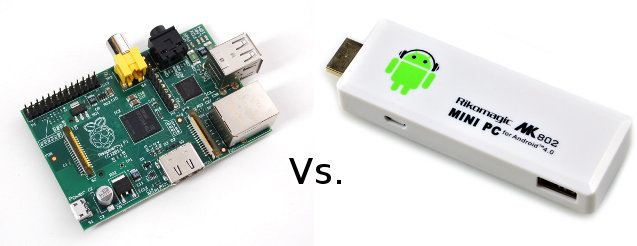MK802 mini PC quickly went viral as it launched in May 2012 for $74 US, and since then many Chinese manufacturers have jumped into the market bringing both new faster devices, and the price down. AllWinner A10s, a low cost version of AllWinner A10 used in MK802, was also launched specifically for this market to bring costs even lower. Today, I’ve been informed an HDMI TV dongle based on AllWinner A10s that sells for $36.55 on Tinydeal.com which is a very good price, but decided to check on Aliexpress to look for comparable deals, and found one shop selling MK802 II for $34.91 including shipping via China Post, which makes it cheaper than the Raspberry Pi model B selling for $35 excluding shipping.

NB: Devices are not shown at the same scale.
Both products target 2 different markets, as MK802 is oriented to the consumer market, and Raspberry Pi targets the educational market, but in practice, it appears people may use the device for similar purpose, for example as a media player or a platform for tinkering with Linux.
Since both products have the same price, and software support & availability have improved since their launch, I’ve just created a side-by-side comparison below.
| MK802 II | Raspberry Pi Model B | |
| SoC | AllWinner A10 CPU: Cortex A8 @ 1.5GHz GPU: Mali-400 |
Broadcom BCM2835 CPU: ARM11 @ 700MHz (OC: 1 GHz) GPU: Videocore IV |
| RAM | 1 GB | 512 MB |
| Storage | 4GB NAND Flash + microSD slot | SD card slot |
| USB | 1x USB 2.0 Host + 2x USB OTG (One USB OTG is reserved for power) |
2x USB 2.0 Host ports |
| Ethernet | N/A (via USB dongle only) | 10/100 Mbit |
| Wi-Fi | 802.11 b/g/n | N/A (via USB dongle only) |
| Video Output | HDMI | HDMI and Composite |
| Audio Output | HDMI | HDMI and 3.5mm stereo out jack |
| Expansion Headers | N/A | Yes. Provide access to GPIO, I2C, SPI, etc… DSI (for LCD display) and CSI-2 (for camera) interfaces are also available |
| Size | 9.7 x 2.8 x 1.2cm | 8.56 x 5.6 x 2.1cm (Board only) |
| Casing | Yes | No (Cases can be ordered separately) |
| Included Accessories | HDMI Cable USB Cable OTG Cable User Manual |
N/A |
| Video Codecs (HW) | H.264, MPEG 1/2/4, VC-1, VP8, and AVS | H.264 only. MPEG-2 and VC1 can be added by purchasing corresponding licenses |
| Linux Support | Good. Stable bootloader and kernel, with SD images provided by the community, but no official distro support |
Very good. Several distributions are available for the platform, and Debian is officially supported (Raspbian) |
| Android Support | Very good. Android 4.0 ICS |
Poor (for now) Android 2.3 without GPU acceleration Android 4.0 in progress |
| Community Support | No official community support, but several (seller) sites provides forums for MK802 such as miniand, and sunxi-linux.org community works on AllWinner Linux development in the open. | Very large community via Raspberry Pi Forums. |
If you just look at the hardware specs, there’s no comparison, and MK802 II provides much better value than the Raspberry Pi with a much faster CPU, more RAM, internal storage and more. Only the GPU processing power may be subject to debate, but I don’t really have data to make a proper comparison. So if you just want to run the device as a media player for example, I’d just go with MK802 II since you’ll get a smoother experience and more video codecs are supported. The only caveat is that you’ll have to use Android (and see the status bar during video playback), as although Linux video support is available, it’s not ready for prime time, and never will.
However, the Raspberry Pi is still a better solution for several use cases:
- Hardware “hacking” – You need to make use of the “GPIO” headers to control external devices.
- Connection to old TV – The Raspberry Pi has a composite video output which allows it to be connected to older TV lacking HDMI
- Beginners – If you’re not familiar with Linux, using AllWinner A10 devices may prove challenging, and it’s much easier with the Raspberry Pi thanks to official Linux distributions, and the Raspberry Pi community.

Jean-Luc started CNX Software in 2010 as a part-time endeavor, before quitting his job as a software engineering manager, and starting to write daily news, and reviews full time later in 2011.
Support CNX Software! Donate via cryptocurrencies, become a Patron on Patreon, or purchase goods on Amazon or Aliexpress




